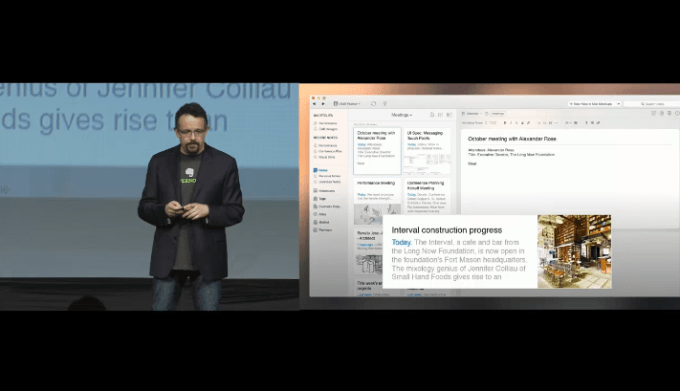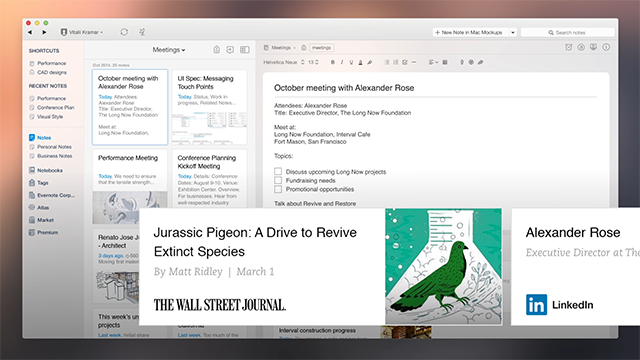
Today, Evernote — the note-taking and storage app now with 100 million users — announced one of its latest and biggest steps forward in its bid to develop services that will not just keep people using its app to store notes and thoughts regularly, but to use it for ever more purposes: it’s launching Evernote Context — an AI play that will see it surfacing and suggesting new content to you from third party sources as you read and write, alongside Evernote’s existing ability to surface relevant content from your own documents and, in Evernote Business, those of your work colleagues.
“Your workspace should have the information that you need,” CEO Phil Libin said today.
This will mean adding a new content feed from third party sources that will appear within Evernote, alongside and relevant to the work that you are doing within the app, wether you are on desktop or another client.
Sources that will show up include social networks like LinkedIn (which outsourced its CardMunch scanning service to Evernote earlier this year and seems to have a wider relationship now with Evernote), data resources like CrunchBase and news sources — such as the WSJ (and TechCrunch, from what I understand). This is part of a wider relationship with WSJ and News Corp., too, which includes swapped-over premium subscriptions where users of Evernote Premium get one year of free WSJ; and WSJ subscribers get a free year of Evernote Premium.
Evernote is likely to launch Evernote Context by “next month”, Libin said.
The news was made public today at the company’s big annual conference, EC4, where Libin talked eloquently on the merits of short-term and long-term decisions and how that applies to life and also to Evernote.
Evernote has long held a wider remit to create a platform that people can use for the rest of their lives and beyond. Moves like adding in more third-party content to use while you are creating documents is more about how Evernote is used for more immediate work and synthesizing ideas.
“The idea is whenever you are working in Evernote, you’re not doing it in a vacuum. You’re not opening up a blank page. Evernote is finding information that is most actionable to you right now,” Libin said today. This is
The idea behind Evernote Context is that it builds upon features that Evernote already have. One, Related Notes, which surfaces your other notes that are related to the one you’re typing in. Evernote Business users, meanwhile, get related notes from coworkers. These are now being rolled into the wider Context service.
Sourcing third-party content in Context will be the next step in that trajectory. It will give you notes in the left margin that will then be able to be brought into the document that you are writing.
When you mention something in your writing, Evernote “reads” this information and suggests links to you, for example contacts from LinkedIn, or data from CrunchBase or a story from one of its partners (in addition to the WSJ and TC, there is Factiva (for those who subscribe), Fast Company, Inc. and Pando Daily. You can then drag info from these cards as a notation into your document in to illustrate what you are writing.

“This changes how you interact with business news,” Libin said, saying that this will help with all four of the pillars that it sees as essential to how people use Evernote: writing, reading, collecting and presenting.
“We’ve tried to make the writing experience across all our clients really polished,” CEO Phil Libin said today. “Evernote wants to be the best place for writing.”
There is also a wider idea here that’s worth highlighting: by bringing in context sources to Evernote itself, it’s also positioning Evernote as a place where people can not only create content, and store interesting things that they have collected elsewhere, but now also discover new content. This is the route that other sites like Facebook, Twitter have taken and have helped transform them from simple services for communication into wider platforms where you can spend a large part of your online life.